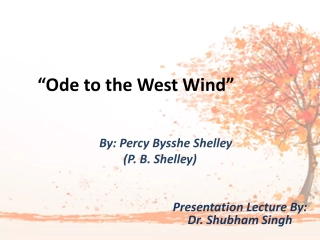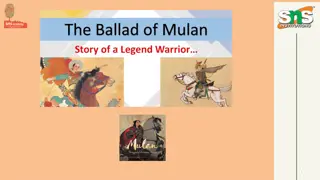
Odes in English Literature: Structure, Types, and Examples
Explore the captivating world of odes in English literature, from their elaborate structure involving strophe, antistrophe, and epode to the different types such as Pindaric, Horatian, and Irregular odes. Dive into the origins, definitions, and examples of odes to gain a deeper insight into this genre of poetry.
Uploaded on | 2 Views
Download Presentation

Please find below an Image/Link to download the presentation.
The content on the website is provided AS IS for your information and personal use only. It may not be sold, licensed, or shared on other websites without obtaining consent from the author. If you encounter any issues during the download, it is possible that the publisher has removed the file from their server.
You are allowed to download the files provided on this website for personal or commercial use, subject to the condition that they are used lawfully. All files are the property of their respective owners.
The content on the website is provided AS IS for your information and personal use only. It may not be sold, licensed, or shared on other websites without obtaining consent from the author.
E N D
Presentation Transcript
The Ode SEMESTER TWO INTRODUCTION TO ENGLISH LITERATURE SIUAIEL21 DR. LAKSHMI MUTHUKUMAR, HEAD, DEPT. OF ENGLISH
DEFINITION A LONG LYRIC POEM THAT IS SERIOUS IN SUBJECT AND TREATMENT, ELEVATED IN STYLE AND ELABORATE IN ITS STANZAIC STRUCTURE.
THE STRUCTURE OF THE ODE The ode has an elaborate structure involving three parts known as the strophe, antistrophe, and epode. Originally, Greek odes were set to music.
The word ode comes originally from the Greek word ( id ), meaning song. The definition of THE ode has thus clearly changed over time, as now it is often used colloquially to refer to any praise or glorification of an individual or thing. ETYMOLOGICAL ORIGIN
TYPES OF ODES The Pindaric The Horatian The Irregular
THE REGULAR OR THE PINDARIC ODE STROPHE: RIGHT TO LEFT ANTISTROPHE: LEFT TO RIGHT EPODE: DANCERS STOOD STILL NAMED AFTER THE ANCIENT GREEK POET PINDAR E.g. Collins Ode to Evening
SHORTER STANZAS (ONLY FOUR LINES EACH) THE SIMILAR ARRANGEMENT WITH RESPECT TO METER AND RHYME HORATIAN ODE THOUGHT CONVEYED IN A STRAIGHTFORWARD MANNER ALSO CALLED THE LESBIAN ODE SOBER STYLE WITHOUT THE PASSIONATE MANNER OF THE PINDARIC ODE e.g.Keats Ode to Autumn
INTRODUCED IN 1656 BY ABRAHAM COWLEY WHO IMITATED THE PINDARIC STYLE AND MATTER BUT DISREGARDED THE RECURRENT STANZAIC PATTERN IN EACH STROPHIC TRIAD. THE IRREGULAR ODE EACH STANZA OF THE IRREGULAR ODE HAS ITS OWN PATTERN OF VARYING LENGTHS. ALSO CALLED THE COWLEYAN ODE e.g. Wordsworth s Ode : Intimations of Immortality
John Keatss Ode on a Grecian Urn is perhaps the most well- known ode ever written. KEATS ODE ON A GRECIAN URN There is rhyme throughout, but it is not as strict as other rhyme forms. Keats wrote this poem to glorify the virtues of classical Greek art; therefore, no other poetic form is as fitting as the ode, which is an example of classical Greek art itself. AN EXAMPLE OF THE IRREGULAR ODE
THANK YOU AND ALL THE VERY BEST FOR YOUR EXAMS!






















